Dante’s Hill is a tiny mound in the lush landscape of the Northern Italian region of the Veneto.
You will find it right next to the small town of Romano d’Ezzelino in the foothills of the mighty Monte Grappa – a mountain that is 1,775 m tall and forms part of the Venetian Prealps.
Next to Monte Grappa, Dante’s Hill is like a little dot. So, it’s easy to simply drive past it while in search of more dramatic destinations in the Veneto. Yet, if you put an hour aside and do the easy hike to Dante’s Hill you will soon find that this tiny mound pulls an unexpected ace card. For it features in Dante’s Divine Comedy.
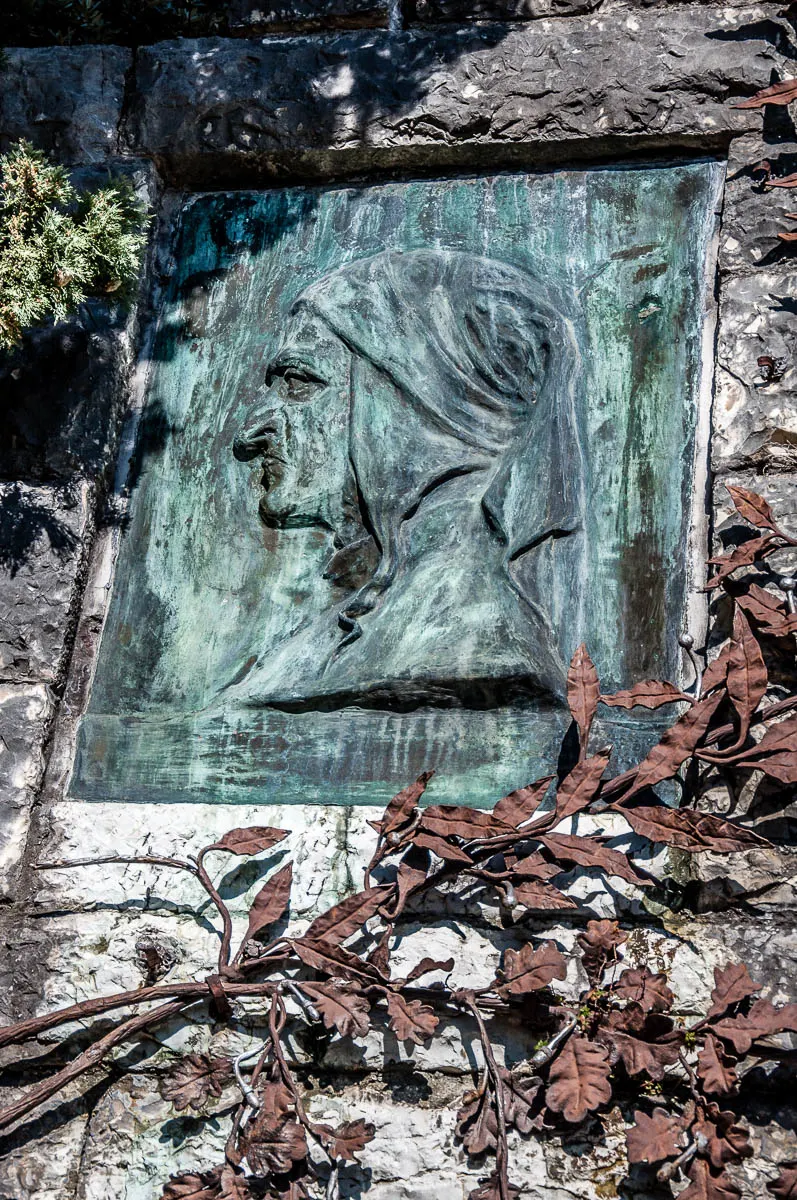
The great poet and father of the Italian language, Dante Alighieri, had an intimate knowledge of the hill in relation to the medieval dynasty of the Ezzelini. They had ruled an ever-expanding patch of land around the hill between the 11th and the 13th centuries.
To this day the local people are incredibly proud of the Dante’s connection. To the point that the hill – originally called Col Bastia’ – nowadays is firmly known locally as Colle di Dante.
A short and easy hike suitable for all ages leads from the nearby town of Romano d’Ezzelino right to the top of Dante’s Hill. From there you can enjoy sprawling views over the Veneto’s plains and hills as well as see a series of art installations inspired by the Divine Comedy.
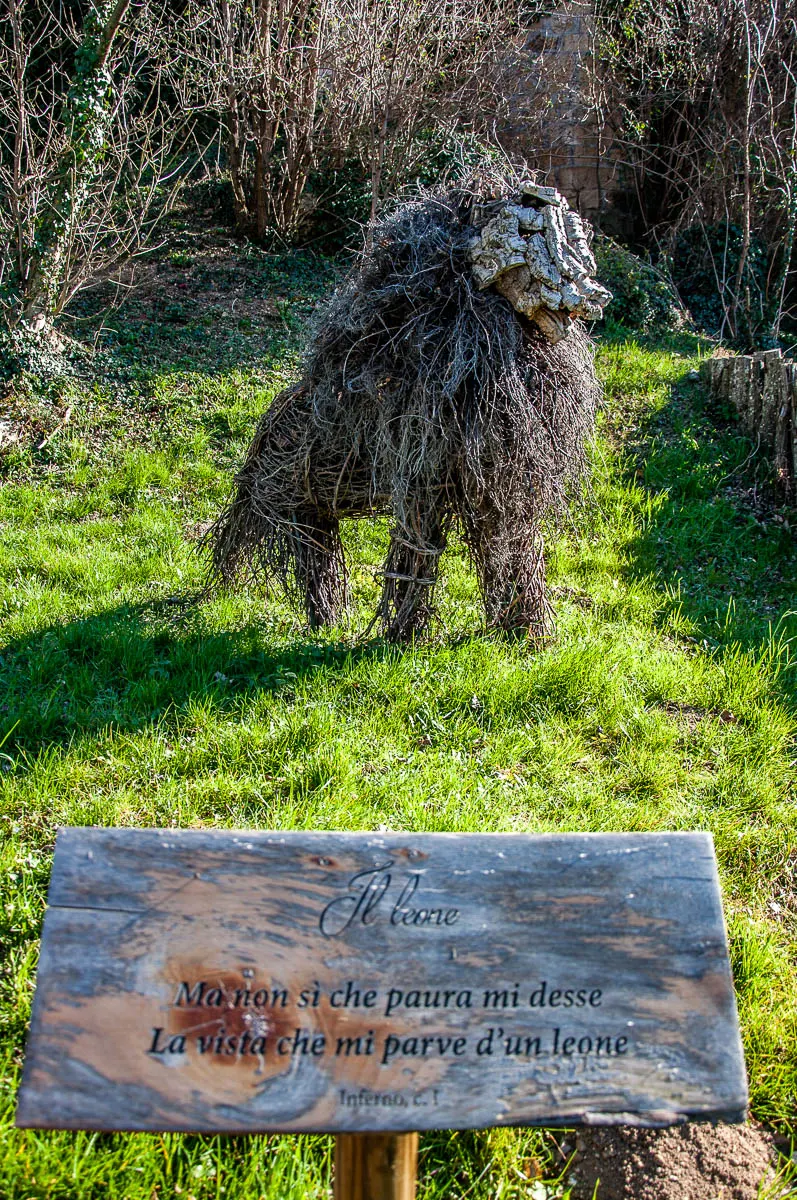
Dante’s Hill is truly one of the hidden corners of the Veneto, a gem that the locals know of and frequent but which is very much off the beaten track for anybody else.
Hence, in this blog post, I want to tell you more about Dante’s Hill, its history, and its literary connection. I also want to give you first-hand tried and tested information as to how to visit this very interesting from a historic, literary, and naturalistic point of view place and experience it for yourself.
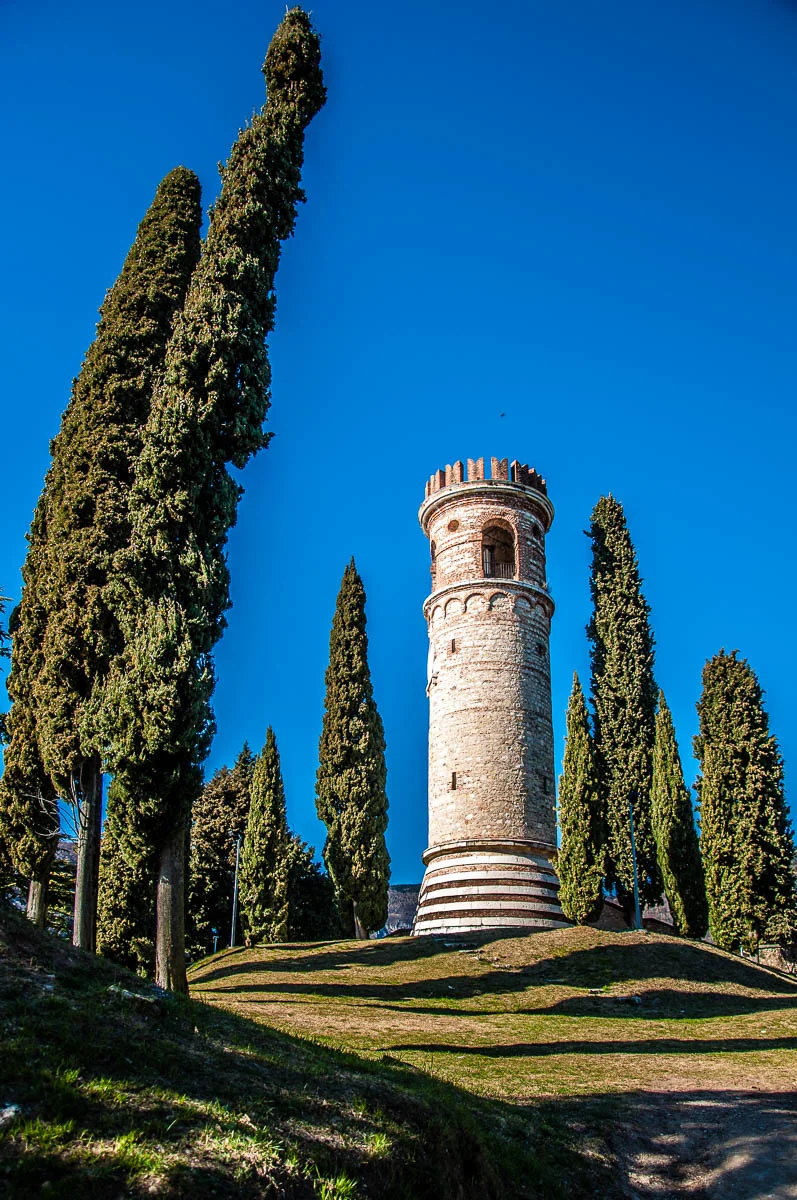
Hiking to Dante’s Hill in the Veneto is an easy and pleasant thing to do any day of the year.
Find out how to do it here!
Dante’s Hill in the Veneto: An Easy Hike in the Steps of Italy’s Greatest Poet
What is Dante’s Hill?
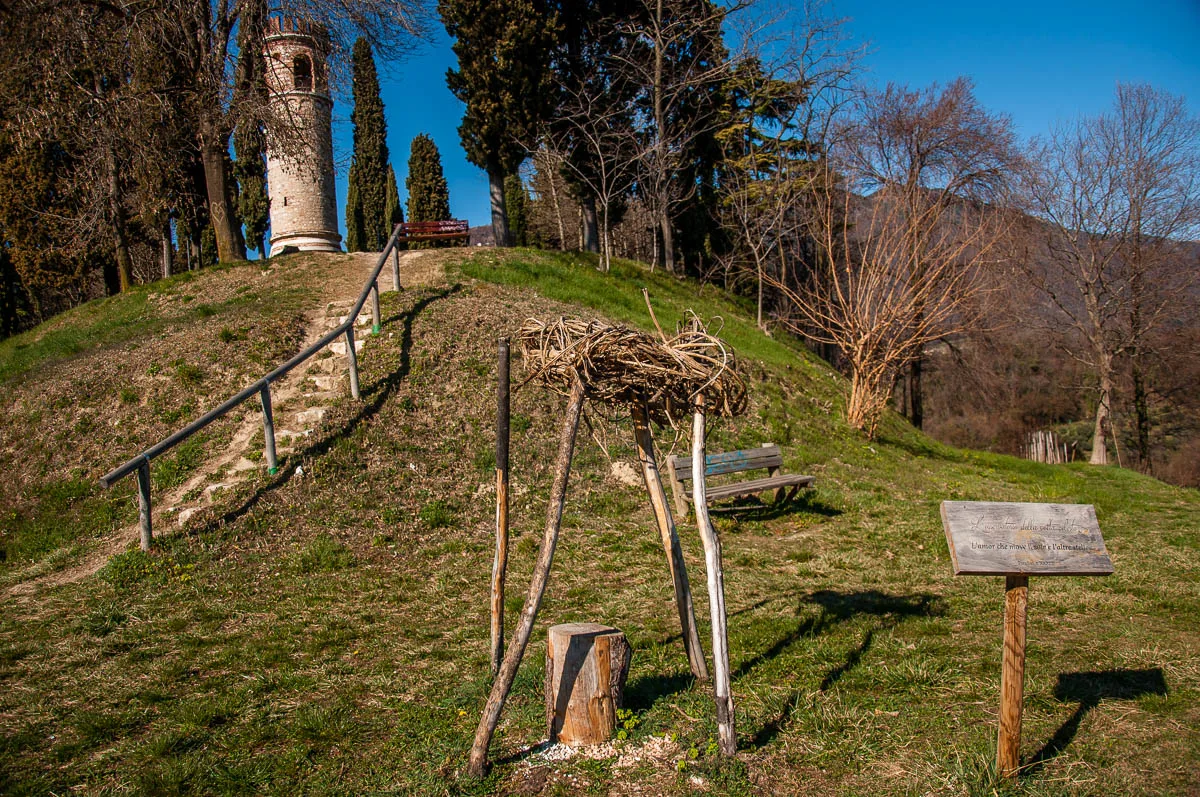
Commonly known as Colle di Dante (in English, Dante’s Hill), the official name of this tiny mound is Col Bastia’.
You will find it on the outskirts of the small town of Romano d’Ezzelino in the foothills of Monte Grappa in the Venetian Pre-Alps in the Northern Italian region of the Veneto.
It is a small and short hill only reaching about 240 m in height. However, it affords a splendid view of the Veneto’s flat as pancake plains and several groups of hills. More interestingly, though, Dante’s Hill has a strong historic connection to one of Medieval Italy’s most powerful dynasties – that of the Ezzelini.
Their castle was built on a nearby hill and remnants of defensive walls and other related to the Ezzelini’s buildings have been found around and on Dante’s Hill.
The dynasty’s most infamous member, Ezzelino III da Romano, waged war against feudal lords and medieval cities, grabbed land from Treviso to Verona, and controlled people and lives with such an iron fist that his bloodthirstiness and cruelty feed his legend to his day. In fact, even nowadays, many locals believe that Ezzelino’s ghost haunts a cave secreted inside Dante’s Hill. Apparently, there, he is kept prisoner by two devils.
Such was Ezzelino III da Romano’s infamy that he is mentioned in Inferno – the first part of Dante’s Divine Comedy. There, Ezzelino is submerged up to his eyebrows in a river of boiling blood in a corner of the Hell reserved for those who, in life, had been cruel to their neighbours.
Cunizza da Romano, Ezzelino’s sister, is also mentioned in Dante’s Divine Comedy. The poet meets her in Paradise – the final chapter of his epic poem. Most precisely, Cunizza inhabits the Third Sphere of Heaven – that ruled by the planet of Venus. She had been an adulteress in life, yet Dante placed her in the Heaven of Venus for she had known what love is and had repented over her sins.
It is Cunizza that makes the direct reference in the Divine Comedy to what nowadays is known as Dante’s Hill in the Veneto. Of the hill she says:
In quella parte della terra prava
Italica, che siede intra Rialto
e le fontane di Brenta e di Piava
si leva un Colle e nonsurge molt’alto…
Of the deprav’d Italian land, which lies
Between Rialto, and the fountain-springs
of Brenta and of Piava, there doth rise,
But to no lofty eminence, a hill…
(Translation according to the Cary Edition of the Divine Comedy)
So proud are the local people of this mention of their small hill in the Divine Comedy that they have kept the Dante’s connection alive and vibrant for many years.
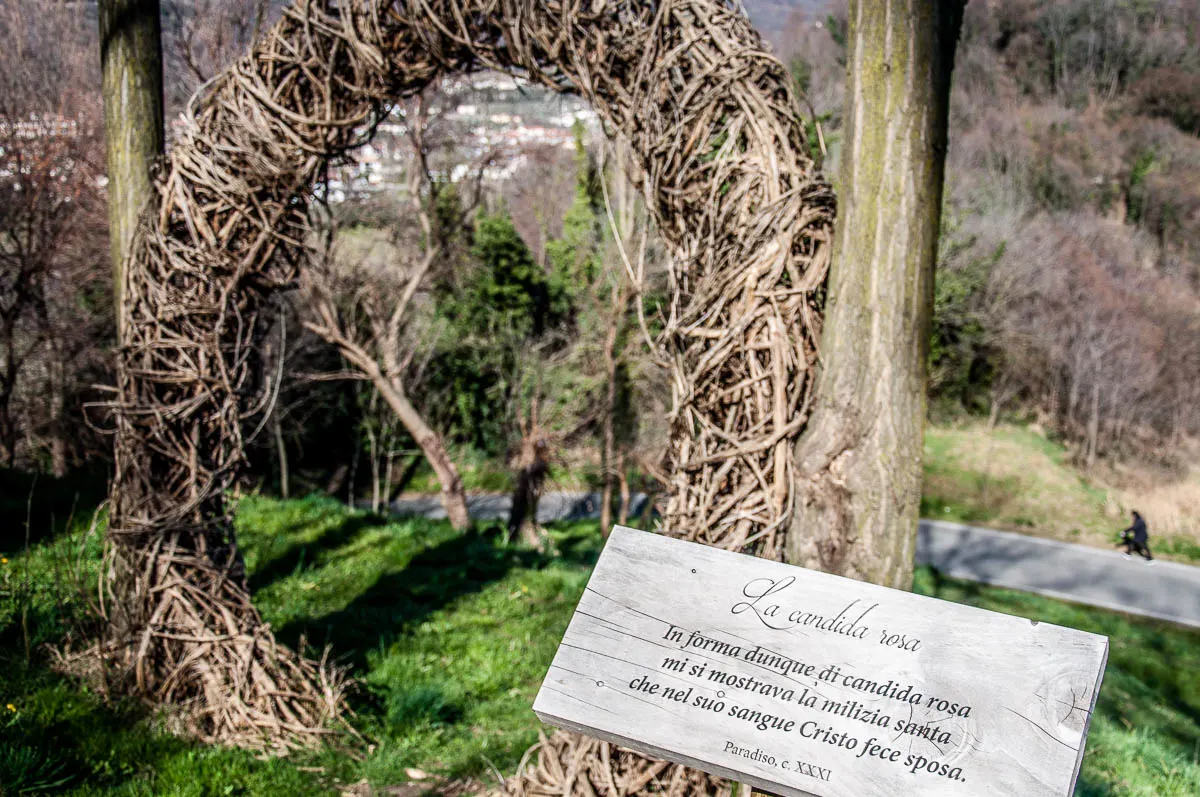
Apart from referring to Col Bastia’ as Dante’s Hill, there is also a lovely trail of art installations inspired by the Divine Comedy that circles the hilltop. Walking from installation to installation allows you to metaphorically complete Dante’s journey through Inferno, Purgatory, and Paradise.
In addition, a monument dedicated to Dante stands on the hilltop’s side in the shadow of a circular bell tower erected there to commemorate the Ezzelini.
Sitting on Dante’s Hill lost in contemplation of the sprawling panorama that opens from the hilltop, it’s easy to imagine Dante sitting right there next to us drawing inspiration for his monumental epic poem. The eye travels fast across the plains of the Veneto. On the horizon stand the whimsical shapes of the Asolani Hills, the Euganean Hills, and the Berici Hills. And behind our back, are the steep slopes of Monte Grappa.
While we are accustomed to thinking of Dante in abstract terms, it is at places like this small hill in the Veneto that we have the unique chance to feel the real connection between history, literature, and people. So, instead of simply perceiving Dante as an important historic figure and giant of human thought, we can see him as a talented person referencing real events and real places.
What to See at Dante’s Hill?

Dante’s Hill is a great place to hike to in the Veneto. With rich connections to the medieval history of this part of Italy, the hill offers splendid view over the lush plains and whimsical hills.
Once you have walked there from the adjacent town of Romano d’Ezzelino, here is what to see and do at Dante’s Hill:
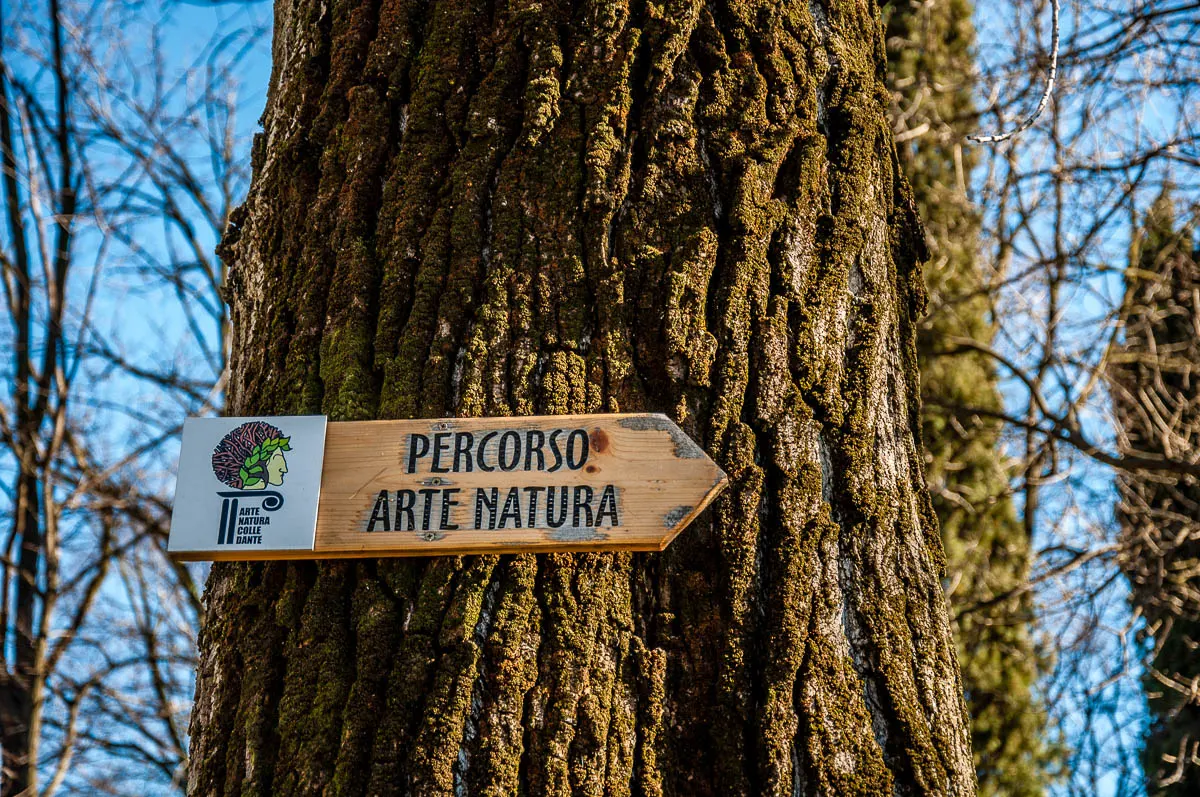
Percorso Arte Natura (Art and Nature Trail) – the hilltop is surrounded by a series of art installations inspired by Dante’s Divine Comedy. Walking from installation to installation, you can metaphorically complete the poet’s journey through Inferno, Purgatory, and Paradise. A wooden sign stands to each installation with a relevant quote from the Divine Comedy carved on it.
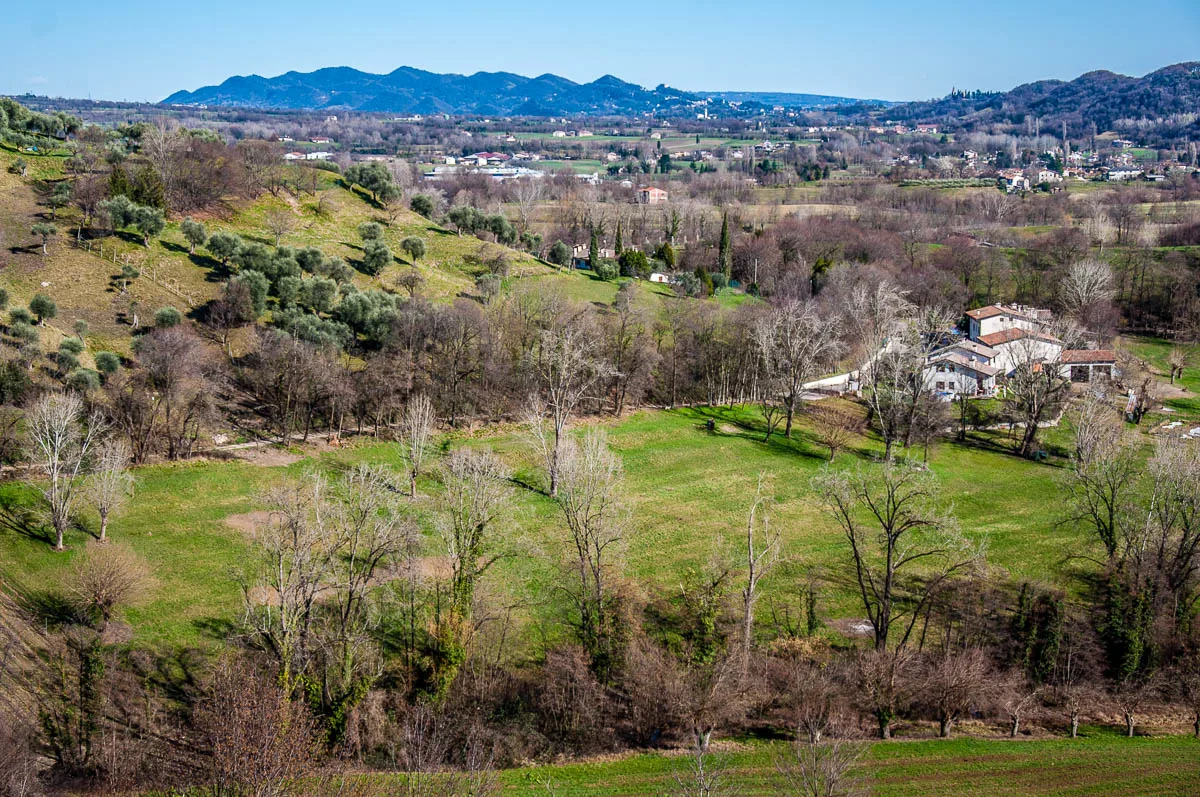
View of Veneto’s hill groups and plains – beautiful panoramic views taking in the landscape of the Veneto. Although small and short, you begin to understand the strategic and observational role what nowadays is known as Dante’s Hill must have played for the Ezzelini’s medieval ruling dynasty.
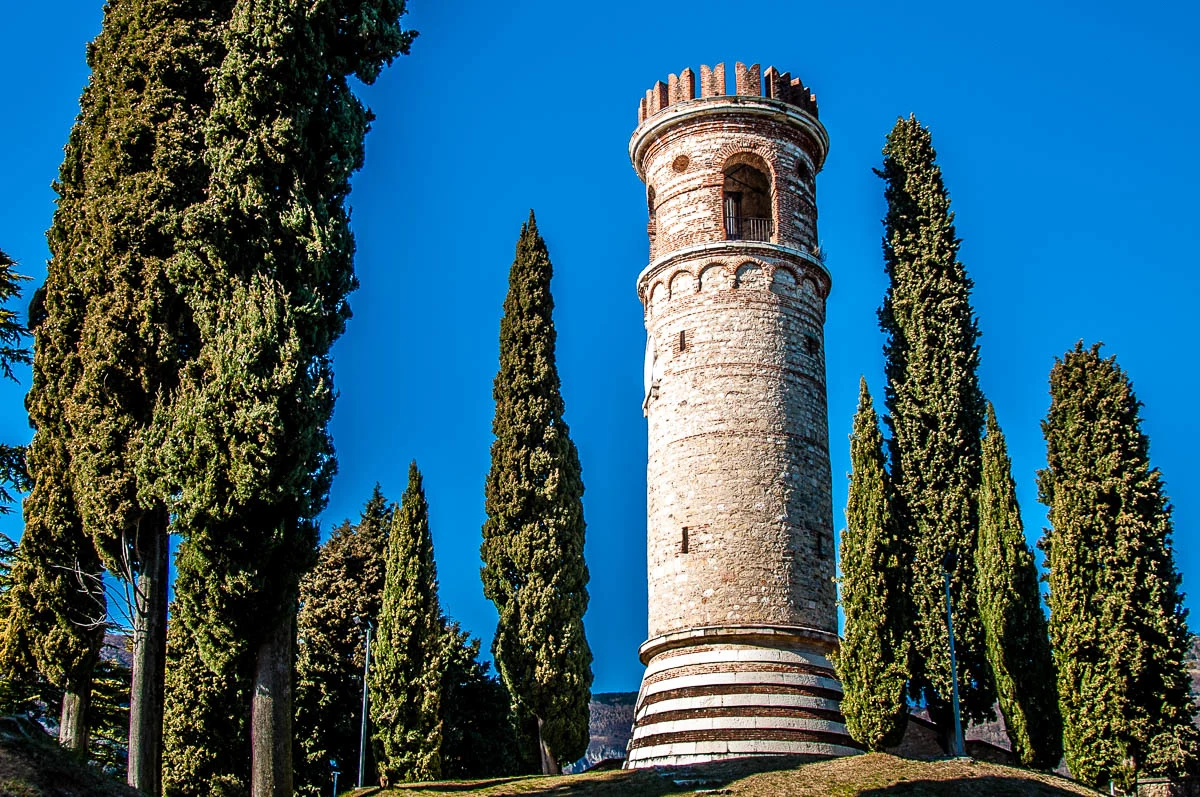
Ezzelini Bell Tower – a circular bell tower, very pretty in appearance, which crowns the top of Dante’s Hill. It reminds me a bit of a lighthouse but instead of guiding ships at sea, it guides the memories of the long-gone past back to this small hill in the Veneto. The tower was built in 1827 in commemoration of the ancient fortress of the Ezzelini dynasty. It was designed by Giovanni Zardo who also worked on the monumental Temple of Canova in nearby Possagno.
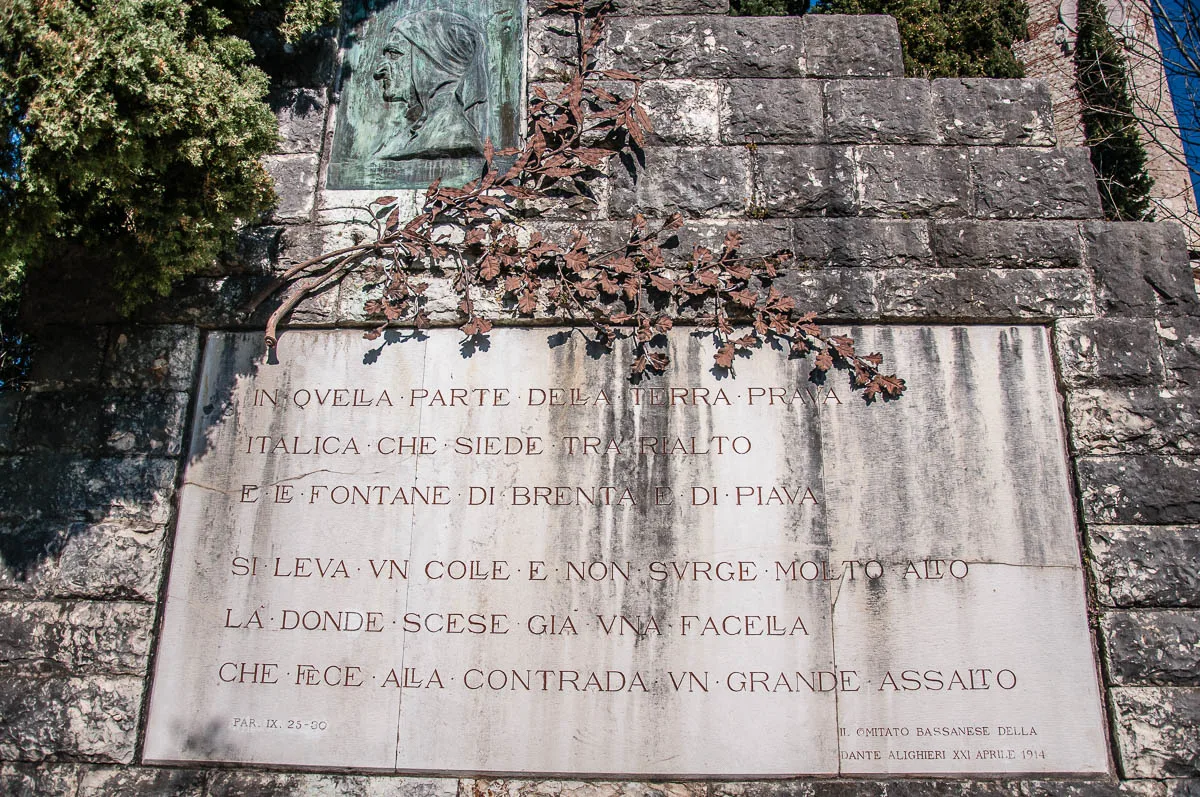
Dante’s Monument – a simple but evocative monument dedicated to Dante and the Divine Comedy. It includes a bas-relief depicting the poet in profile and crowned with laurels. Underneath, the Divine Comedy’s verses making a reference to Dante’s Hill have been chiseled in Italian.
Ezzelini Church – restructured many times during the centuries, this small church in the local cemetery at the back of the Ezzelini Tower was first mentioned in documents in 1085.
How to Reach Dante’s Hill?
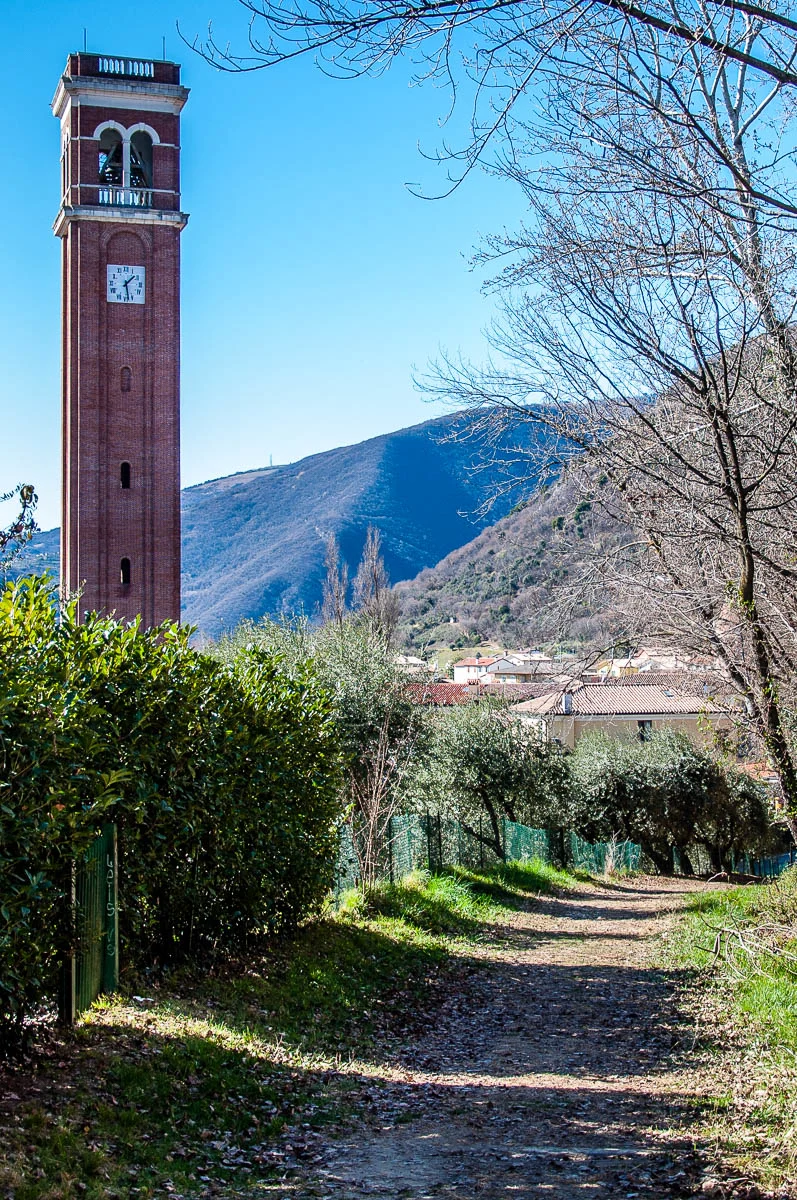
Dante’s Hill is on the outskirts of the small town of Romano d’Ezzelino in the Veneto.
An easy and quick way to visit the hill is to follow the path of a short and suitable for all abilities hike which is quite popular locally. Known as the Graziano Marin’s Hike, it starts right opposite the parking area at the back of the town’s Parrocchia della Purificazione di Maria – a parochial church erected at the end of the 19th century.
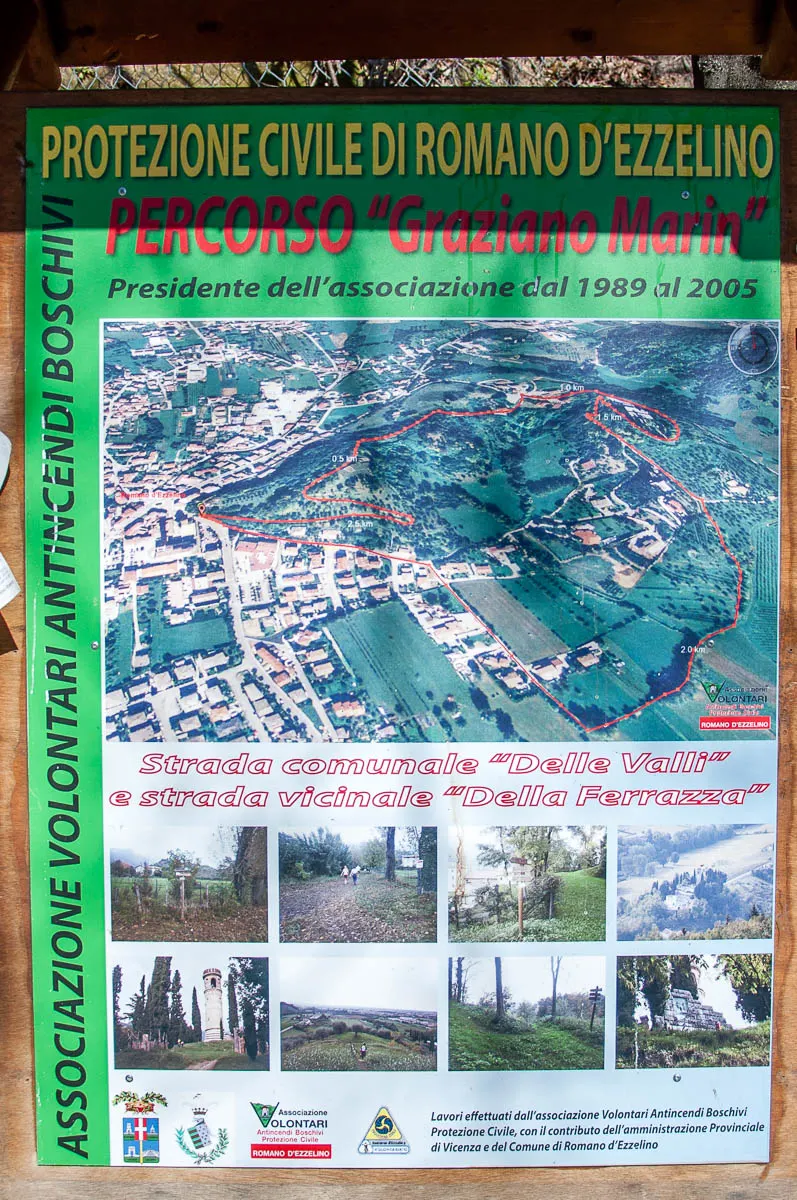
Once you have left your car in the shade of the olive trees that grow in the car park, cross the street, and you will see the above informational board. It outlines the circumference of the Graziano Marin’s Hike and points the way to follow.
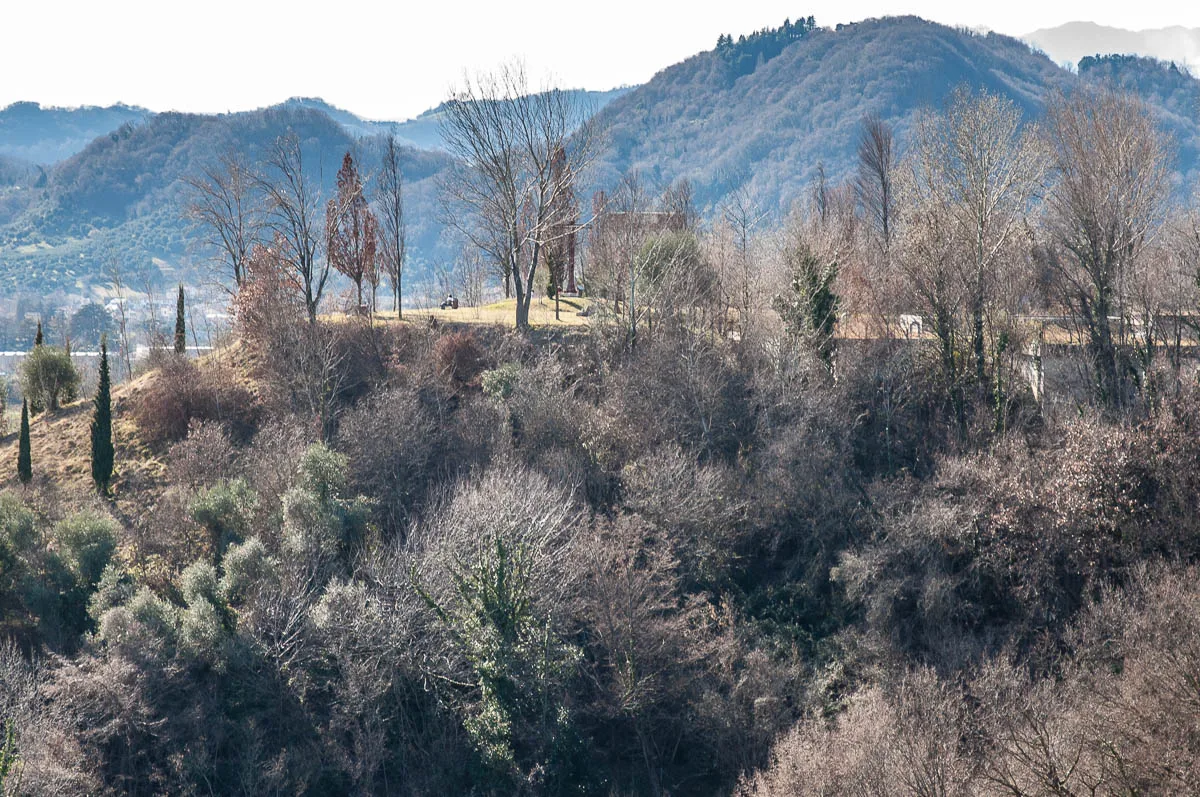
The hike leads from Romano d’Ezzelino first up to Col Molin. This is a flat-top mound with benches and views over the surrounding hills and plains. At its base, you will see the building of the local water supply company which is fenced off. Then, the path curves through a forest, passes by some local houses, and then goes up to Col Bastia’ which, nowadays, is known as Dante’s Hill.
Another way to reach Dante’s Hill is to drive to Romano d’Ezzelino’s cemetery which is at the back of the hill. Still, the parking space at such places is traditionally reserved for visitors of the cemetery, so, please, approach with caution and respect.
How to Do the Graziano Marin’s Hike?
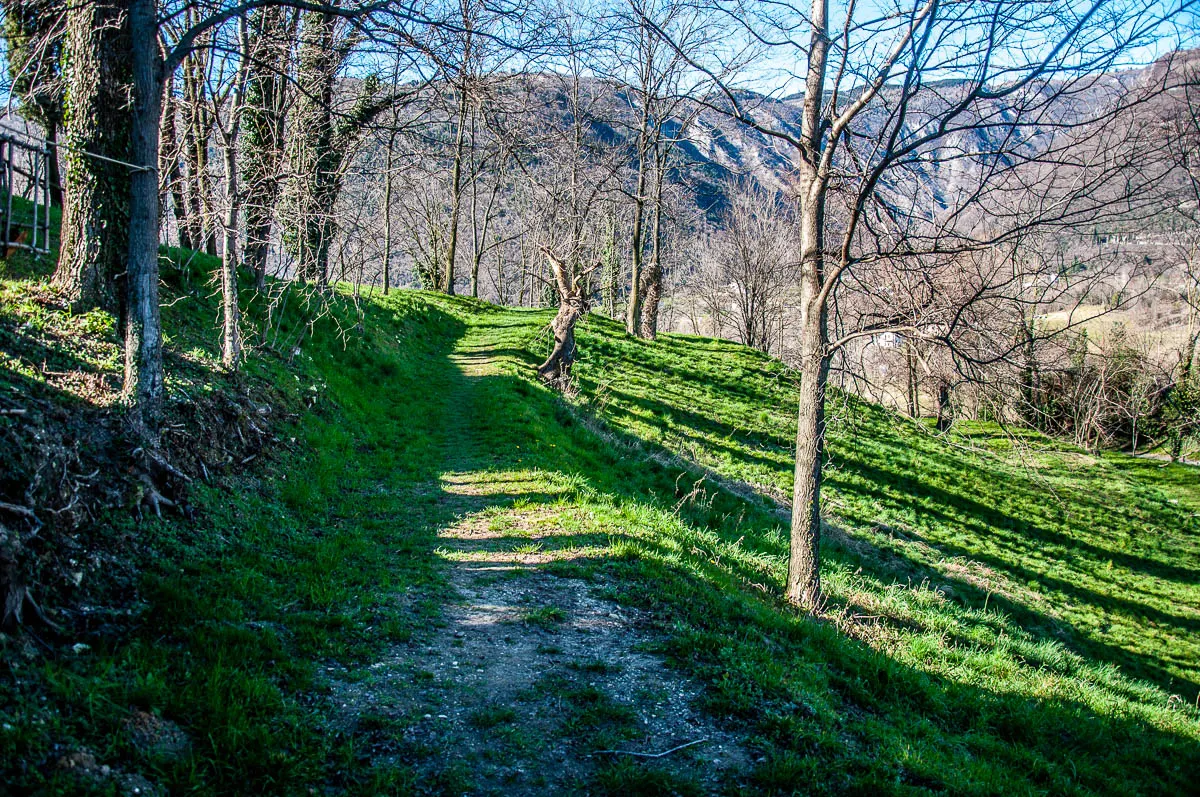
The hike doesn’t take long to do. You can fit it in about an hour to an hour and a half. This does not include any time you may want to spend on Dante’s Hill.
You can find the full outline of the Graziano Marin’s Hike (called Percorso Graziano Marin in Italian) on Google Maps. You will see on the map its starting point – the car park of the town’s parochial church – and how the hike then loops through a forested area around the two hills and returns to its point of departure.
At times, the path gets close to local houses and follows tarmacked roads. Still, you will be surrounded by green lush nature all throughout.
The hike is very easy so you can really enjoy just walking through nature rather than getting out of breath or straining yourself. If you want, bring your Nordic walking sticks or go there for a nice jog.
The elevation is only 150 m in total and the total length of the hike is about three kilometres and a half. Dante’s Hill is only about 240 m high, so there is no difficulty at all in reaching its top.
What Do You Need to Do the Graziano Marin’s Hike?
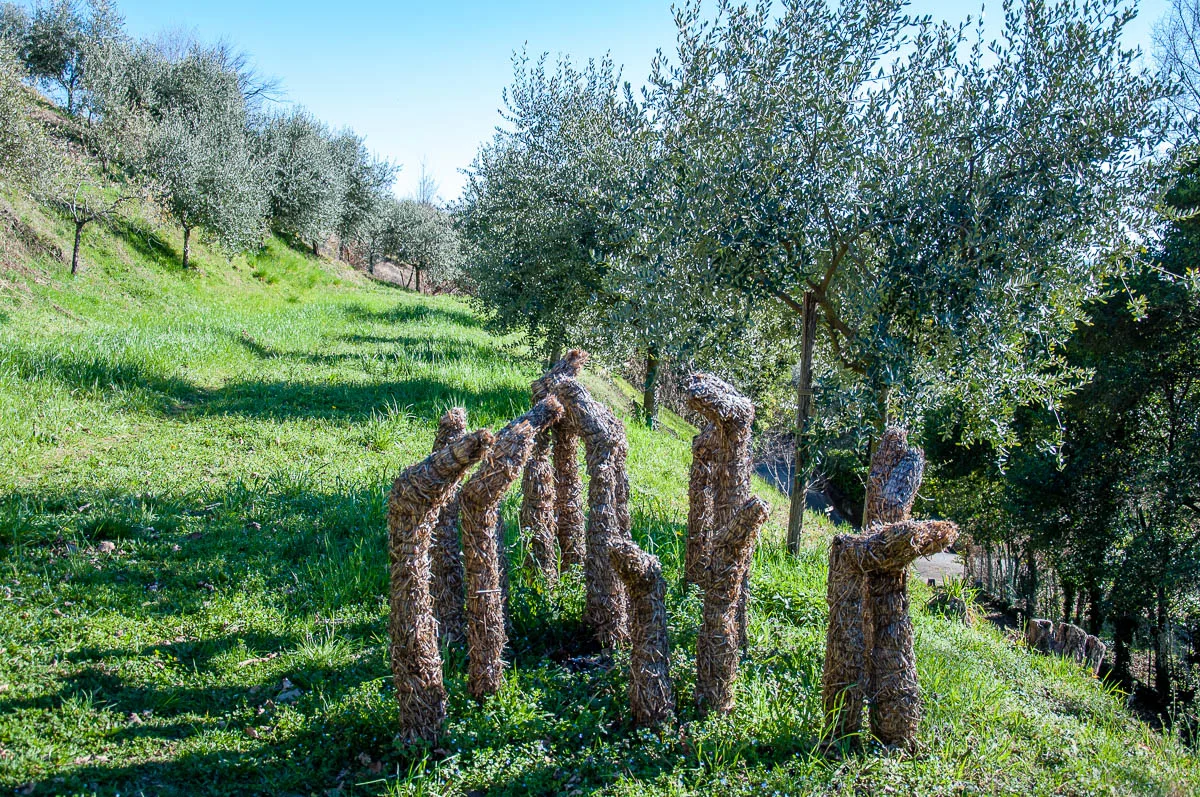
The Graziano Marin hike is a very easy and light trek to be enjoyed by people of all ages and hiking abilities. It is particularly suitable for families and kids will enjoy running along the path, looking at wildflowers, and then, stopping at each station of the Dante’s Art and Nature Trail at the top of Dante’s Hill.
You don’t need anything special to do this hike. The path is in the immediate vicinity of the small town of Romano d’Ezzelino and even when surrounded by nature you are never truly far from civilisation. Also, the elevation is minimal.
Still, as part of good hiking practice, hiking shoes with a good grip are always a must. Comfortable clothes will make your hiking experience so much more enjoyable.
Bring water and, if you want, some light snacks.
For tips on how to prepare for a hike in Italy, please, read this interview with an expert hiker.
Who are the Graziano Marin’s Hike and Dante’s Hill Suitable For?
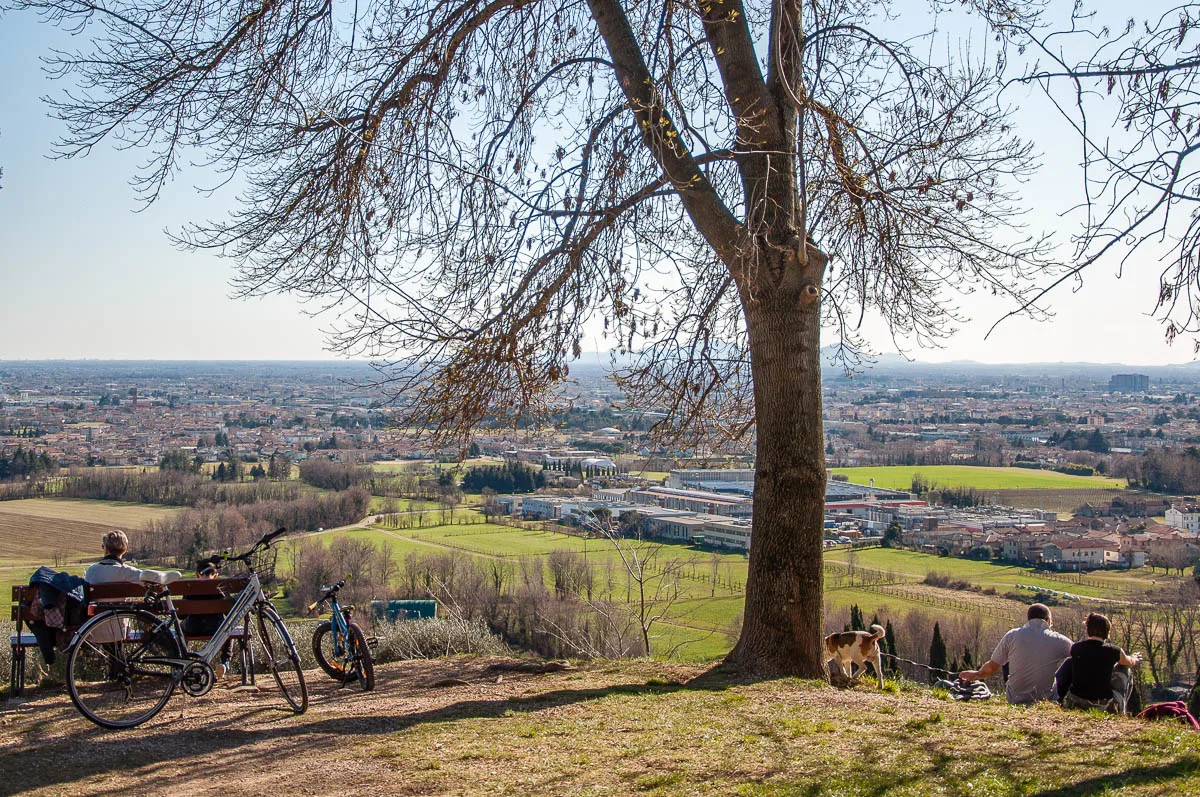
The Graziano Marin’s hike and Dante’s Hill are suitable for hikers of all abilities. Families with children will find the walk easy and pleasant to do.
Both the hike and the hill are very popular locally. While not overrun with people and for most of the time offering complete peace and quiet, usually, you will never be too far away from other people.
At certain points along the hike, the path goes close to the houses and gardens of local people. Please, observe the rules of common decency and avoid making noise and/or other nuisance especially during the hours of riposo – the Italian traditional extended lunch break.
When Is the Best Time to Do the Graziano Marin’s Hike and Visit Dante’s Hill?
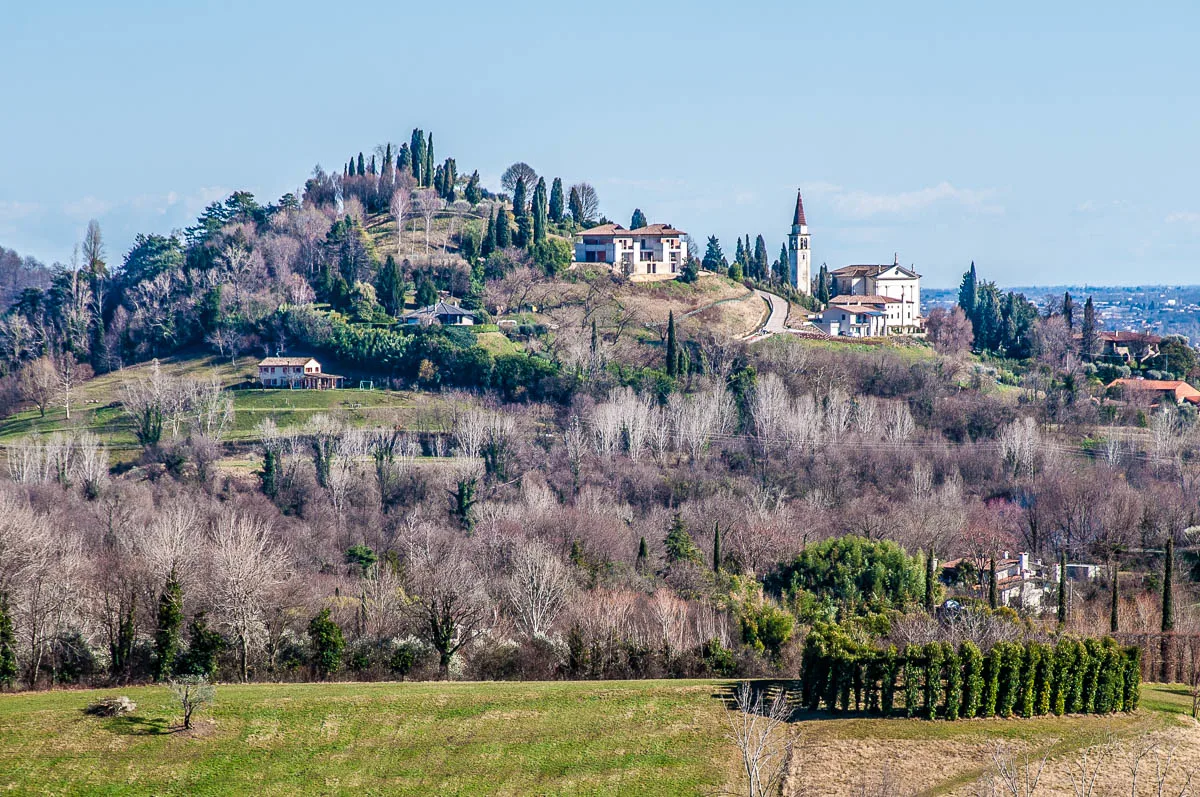
On a crisp and clear day. This way you will enjoy the best views across the plains of the Veneto all the way up to the Asolani Hills, the Euganean Hills, and the Berici Hills.
Late spring is a particularly beautiful time of the year to visit Dante’s Hill in order to enjoy the lush view of olive trees, cypresses, and seemingly endless meadows from above.
However, a visit at any other time of the year will not leave you disappointed.
My Personal Experience Visiting Dante’s Hill
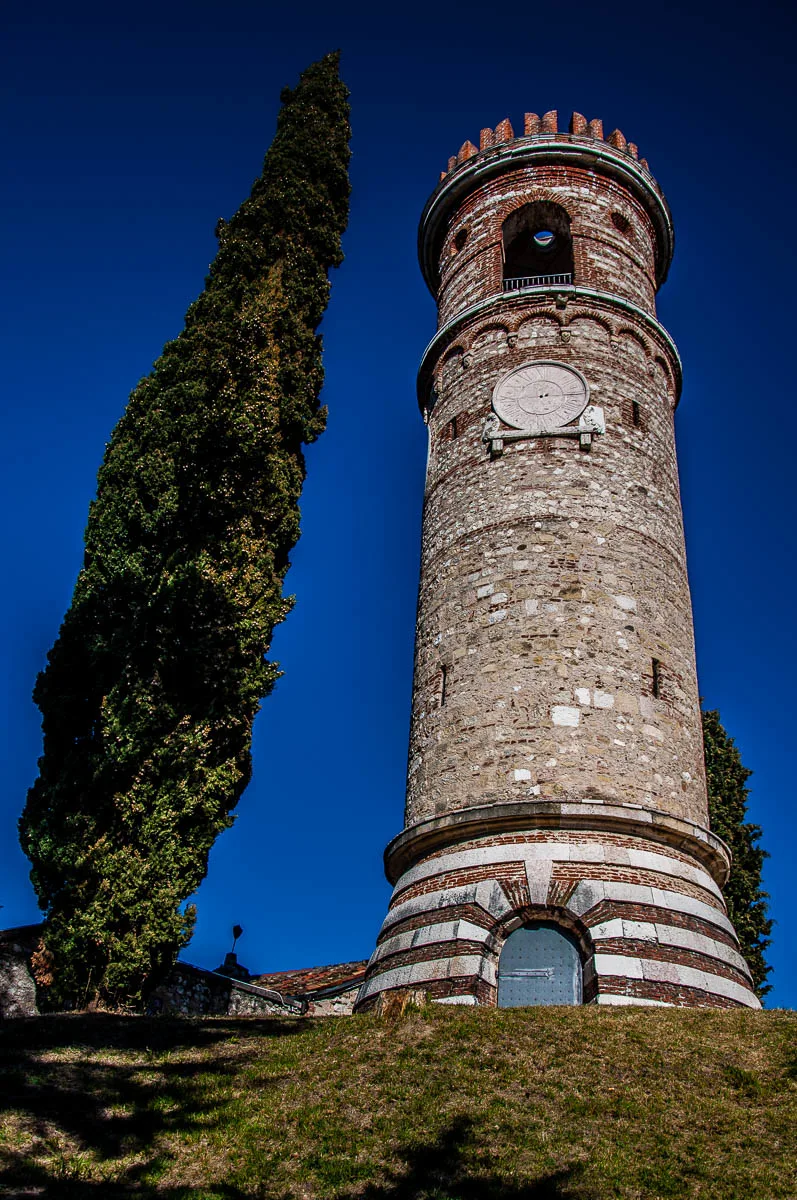
One of the things I love the most about Italy is the ability to feel close to historical figures whom we traditionally think of in abstract terms. Here, it’s actually possible to visit their birth houses, see first-hand places that they used to frequent, and learn about the squabbles they had and the purely human emotions they experienced during their lives.
This humanises them in our minds and we can then approach their works of literature, science, and art with a bigger understanding of what made them be who they were as people and creators.
As such, I love visiting places here in Italy, often off the beaten track, that one way or another are related to the country’s most famous daughters and sons. Petrarch, Elena Cornaro Piscopia, Cima da Conegliano, Titian, and so many others. I thoroughly enjoyed every minute spent learning about them in the context of the places where they had lived, loved, and worked.
So, I was very excited when I found out that not far from Vicenza, where I currently live, there is a small hill that is mentioned in Dante’s Divine Comedy.
This seminal work of literature name-checks dozens if not hundreds of Dante’s contemporaries (alongside mythical creatures, legendary heroes, and Classical personalities). The great poet has managed to compartmentalise several generations of medieval dynasties and illustrious figures according to his political, philosophical, and religious beliefs. And it is through visiting the real-life places that Dante referenced, visited, and lived in and close to that we can feel the actual human relationships and emotions that his work is charged with. This way it’s easier to understand it, too rather than think of it as simply a heavy and abstract text to read.
Dante’s Hill is very pretty, very easy to reach, and it offers lovely views over the Veneto’s plains and hills. Standing on the flat top of the hill, my eyes travelled far, all the way to the horizon against which the outlines of the Asolani Hills, the Euganean Hills, and the Berici Hills stood sharply chiseled out.
To reach Dante’s Hill, we drove from Vicenza up to Romano d’Ezzelino – a small town I had visited a few years ago for its annual donkey race. Yes, it’s a big thing locally! You can read more about it here.
We hiked from the town up to Dante’s Hill following the Graziano Marin’s trail. It was very easy and quick hike to do. Dante’s Hill is more or less halfway through it.
Once we reached Dante’s Hill, we spent some time looking at the different art installations that recreate important moments from the Divine Comedy and are set up in a ring around the hill. In our faltering Italian, we read the literary quotes on the wooden signs placed next to the installations. It was a lovely way to set the stage, to make you understand that this is a special place, a crossroads of history and literature.
We then spent some time just taking the views in and after that walked up to the Ezzelini Tower. We found it closed. I am afraid, I don’t know if it is ever open for visits. From there, we walked the few steps down to the side of the hill on which Dante’s monument is placed and then we continued the circular hike until returning to our car parked at the back of the parochial church.
It was a great experience!
Has Dante himself visited Dante’s Hill in his lifetime?! To be perfectly honest, I don’t know for sure.
After his expulsion from Florence, the great poet spent several years of his life in Verona – at the time ruled by the medieval dynasty of the Scaligeri. There, Dante wrote the final part of his Comedia – Paradise.
It’s a fact that in the Divine Comedy, Dante references over a dozen real places in the Veneto. For his writing he took inspiration from real-life events, people, and places.
It is, certainly, nice to think that Dante must have visited Col Bastia’ near Romano d’Ezzelino. Perhaps, he stopped there on a hike to the nearby Monte Grappa?! Or perhaps he heard about it from Cunizza – Ezzelino III da Romano’s sister – whom, some researchers say, Dante could have met in Tuscany where she lived in her old age.
Why Is Dante So Important for Italy?
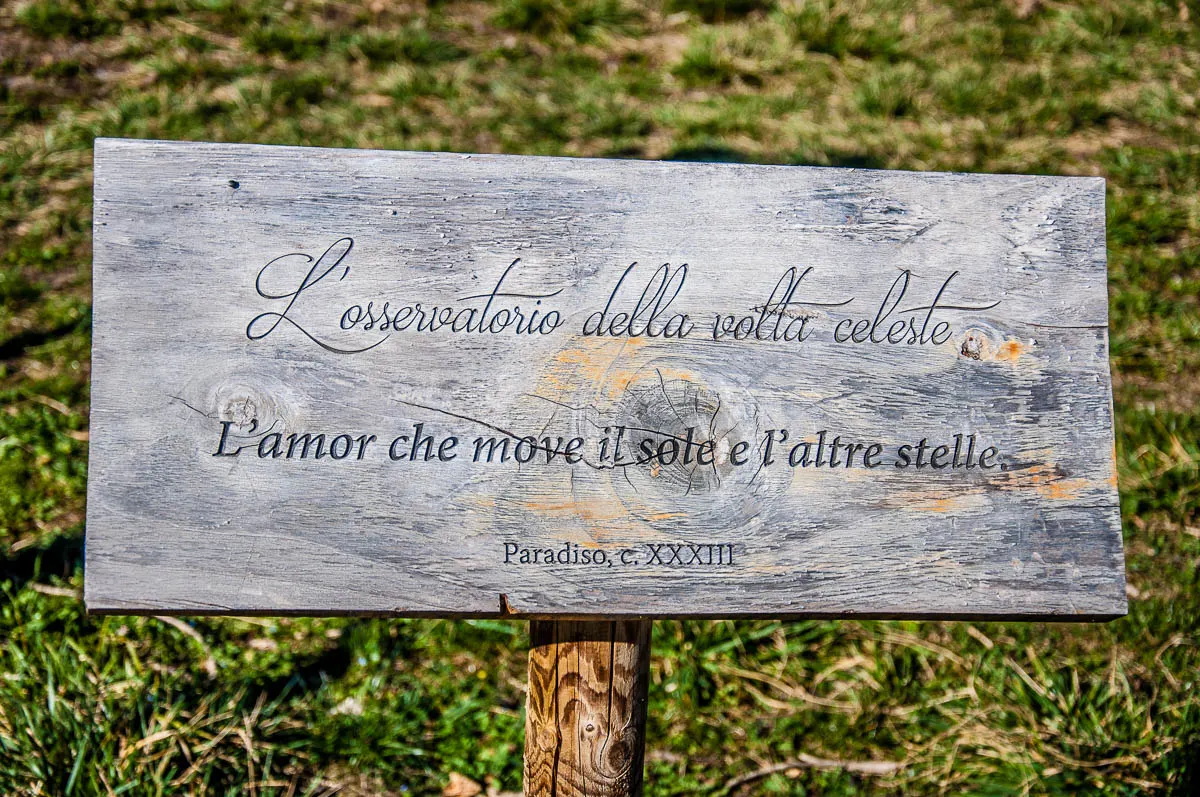
At a time when erudite authors wrote in Latin for a similarly highly educated but limited audience, Dante was quite a groundbreaking figure. He composed and wrote his Comedia (it was only after his death that it became known as the Divine Comedy) in the Florentine vernacular. In other words, this was the language spoken by his contemporaries from the city-state of Florence.
It sounds like Dante preferred to be widely understood rather than his writing only reaching a selected few.
His Divine Comedy (with ‘Divine’ being added to the title by Giovanni Boccaccio of the Decameron fame) became the standard on which what nowadays is known as the Italian language was based. As such, Dante’s poetry actively shaped the language of the whole of Italy.
In addition, Dante’s Divine Comedy laid the literary threshold between the Middle Ages with their focus on the Divine and the advent of the Renaissance with its Humanist credo.
To this day, the Divine Comedy remains one of the most influential literary works in the world. It has inspired countless works of art, it has fed a priceless stream of information to historians researching Italy’s Middle Ages, and it has become a multifaceted reference that transcends cultures and nations.
What Else to Do in the Vicinity of Dante’s Hill?
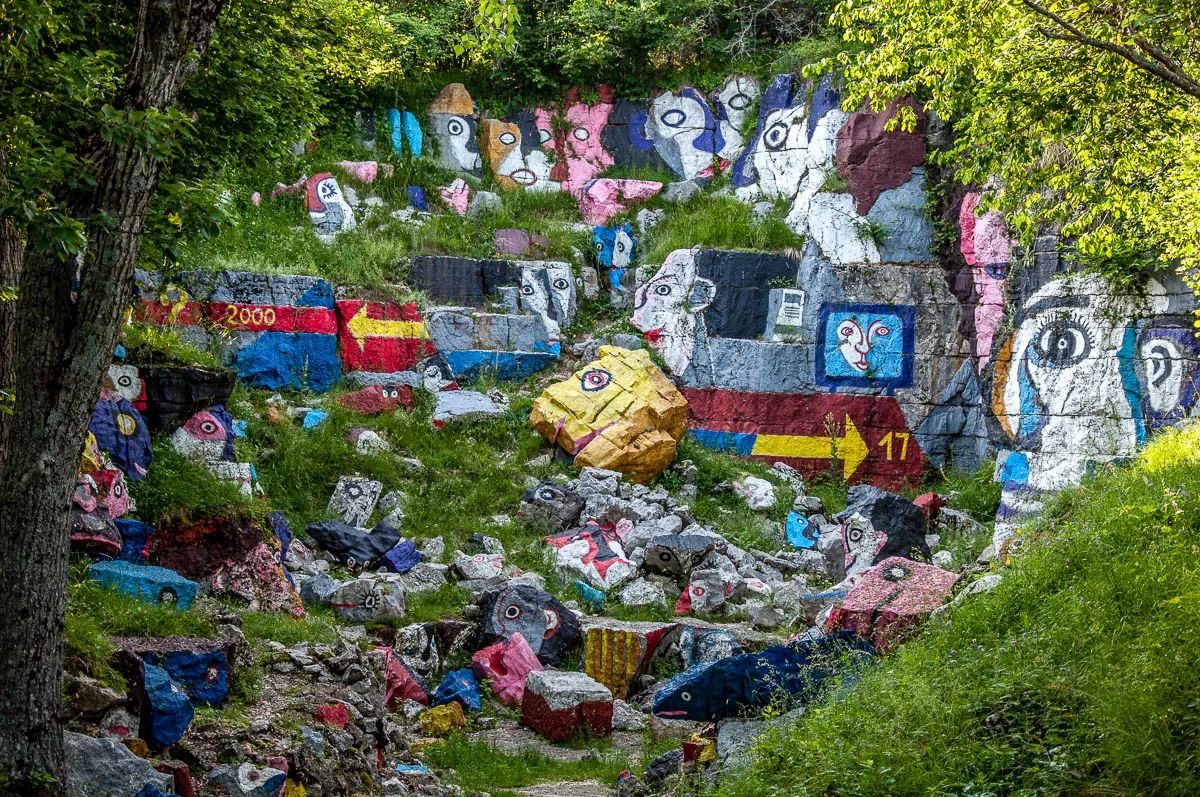
While you can spend a happy hour or two hiking from the small town of Romano d’Ezzelino to Dante’s Hill and back, there are many other wonderful sights and places to be seen and enjoyed in the immediate vicinity. This way, you can combine a visit to Dante’s Hill with another local sight and have a great day out taking in the beauty of the Veneto.
Here is a nice and tidy shortlist to give you some ideas:
- Bassano del Grappa – approx 10 mins away. A beautiful city with gorgeous sights, excellent museums, a Palladian bridge, stunning river views, and a museum dedicated to the production of grappa – the local strong alcoholic drink. You can combine it with a visit to nearby Marostica and/or Nove.
- Grotte di Oliero – approx 11 mins away. A small but beautiful cave that can be accessed only via a short boat ride. The cave is in a lovely park where you can go for a nice relaxing walk. Read more about it under point 5 in this list with easy hikes and walks in the Veneto.
- Nove – approx 15 mins away. A small town famous for the local ceramic-making traditions. Come here to shop handmade ceramics and to visit the excellent Ceramics Museum. You can combine it with a visit to nearby Marostica and/or Bassano del Grappa.
- Possagno – approx 15 mins away. A small town famous for being the birthplace of Italy’s most lauded Neo-Classical sculptor Antonio Canova. Come here to visit his birth house, the adjacent Gypsotheca, and the Tempio Canoviano – a stunning temple combining Rome’s Pantheon and Athen’s Parthenon in one – where the sculptor is buried. You can combine it with a visit to nearby Asolo and/or Villa di Maser.
- Marostica – approx 20 mins away. A charming medieval walled town with two castles and a checkerboard main square. Famous for the local cherries, Marostica holds many events and festivals and it is a lively, beautiful place to visit and explore. You can combine it with a visit to nearby Nove and/or Bassano del Grappa.
- Cittadella – approx 20 mins away. Another beautiful medieval walled town in the bosom of the Veneto. Come here to walk on Cittadella’s defensive wall which circumnavigates the whole historic centre and allows you to admire the town from above. You can combine it with a visit to nearby Castelfranco Veneto.
- Asolo – approx 25 mins away. A hilltop town with cobbled streets and stunning views, Asolo is known as the town of hundred horizons and it has been attracting royals, poets, and artists for centuries. You can combine it with a visit to nearby Villa di Maser and/or Possagno.
- Villa di Maser – approx 25 mins away. A stunning Palladian villa frescoed by the great Renaissance artist Paolo Veronese. You can combine it with a visit to nearby Asolo and/or Possagno.
- Castelfranco Veneto – approx 30 mins away. A lovely medieval walled town where Giorgione, one of the most enigmatic painters of the Italian Renaissance, was born. You can combine it with a visit to nearby Cittadella.
- Rubbio’s Painted Caves – approx 35 mins away. Abandoned limestone quarries that have been turned into an open-air art installation by an artist from Bassano del Grappa. An unexpectedly colourful and creative place to visit in the bosom of nature.
- Monte Grappa – approx 40 mins away. A mountain in the Veneto that is 1775 high. Monte Grappa was one of the most important pillars of the Italian defense during World War I and a refuge for Italian partisans during World War II. A military memorial monument was inaugurated on top of Monte Grappa on 22 September 1935. In its central body lie the remains of 12,615 soldiers, most of whom are unknown.
- Vicenza – approx 45 mins away. An elegant Italian city dotted with Palladian buildings and interesting museums. It’s at the foothill of Monte Berico at the top of which you can visit one of the most important sanctuaries dedicated to the Virgin Mary in Italy.
- Parco del Sojo – approx 50 mins away. An art and nature park dotted with dozens of contemporary art installations. A great place to go for a walk to in order to get close both to art and nature.
In Conclusion
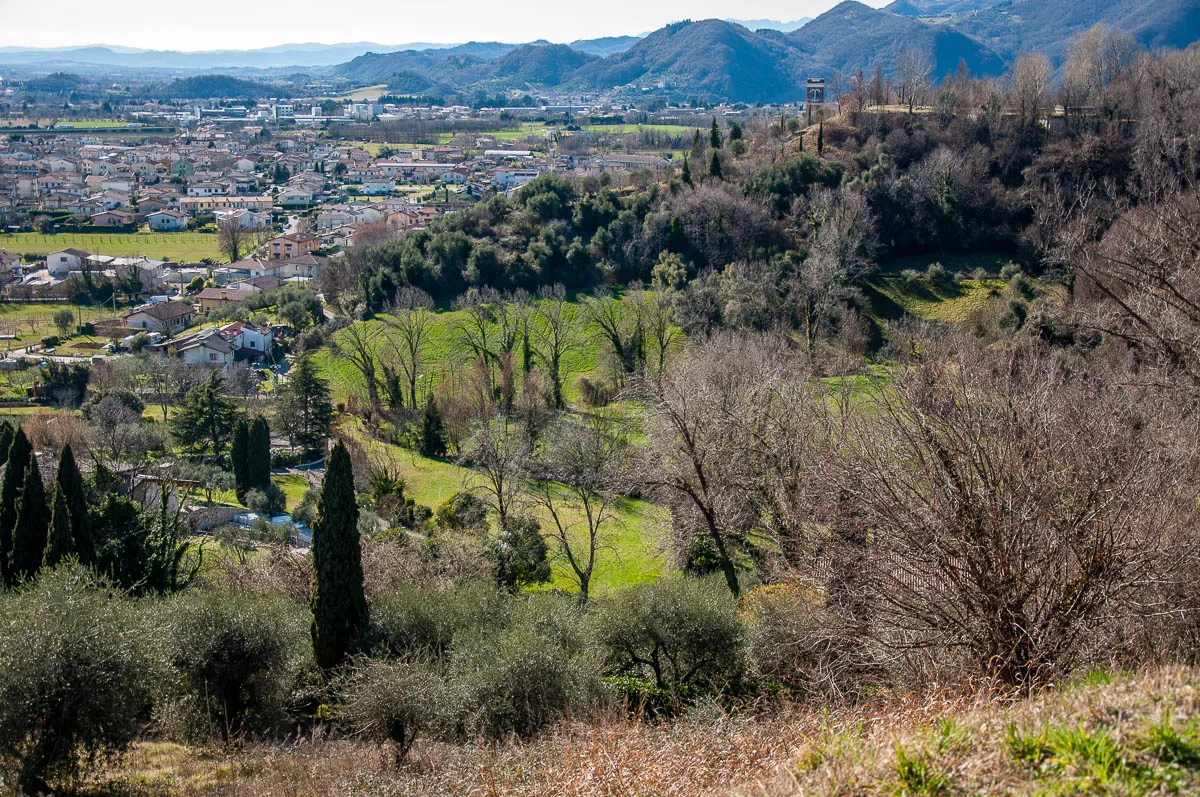
Dante’s Hill – a small mound in the lush nature of the Northern Italian region of the Veneto – hides an unexpected ace card. It is featured in Dante’s Divine Comedy and it served as a playground of a cruel medieval dynasty. It is said that the ghost of its most infamous member haunts a secret cave in the hill to this day.
Opening stunning views over the Veneto’s plains and groups of hills, Dante’s Hill is a great place to hike to on a clear day.
The above blog post gives you full details about the history and the literary connections of Dante’s Hill in the Veneto. It also includes first-hand tried and tested tips about visiting the hill.
I hope that the information provided will galvanise your interest in the history and nature of the Veneto. And that a hike to Dante’s Hill will be at the top of your list of things to do and hidden gems to see for yourself in this corner of Italy.
More Helpful Links for Nature Walks, Fabulous Hikes and Unforgettable Day Trips in Italy
- 30 Days of Adventures in the Veneto, Italy – #30daysofadventures
- Top 15 Places to Visit in the Veneto, Italy – The Ultimate Guide
- Hiking in Italy – Practical Tips from an Experienced Hiker
- 20 Family-Friendly Walks and Hikes Up to an Hour and a Half from Vicenza, Italy – First Part
- 20 Family-Friendly Walks and Hikes Up to an Hour and a Half from Vicenza – Second Part
- Walking the Path of the Big Trees – An Easy Hike in the Little Dolomites in Northern Italy
- Campo di Brenzone – A Great Day Trip to a Medieval Village in the Hills Above Lake Garda, Italy
- Parco delle Cascate and Molina – A Great Day Out in the Province of Verona
- Sanctuary of Madonna della Corona – Visiting Italy’s Church Suspended Between Heaven and Earth
- Six Hidden Corners Around Vicenza, Italy to Quickly Get in Touch with Nature When You Need It
- Grotte del Caglieron – Caves, Waterfalls, and Cheese – A Great Day Trip in the Veneto, Northern Italy
- Hiking in the Dolomites: Grotta Azzurra di Mel – A Beautiful Hike in the Veneto, Northern Italy
- Best 12 Towns to Visit around Lago di Garda – Italy’s Largest Lake
- 8 Most Beautiful Villages to Visit in the Veneto, Italy
- Paneveggio – Exploring the Violins’ Forest in the Dolomites, Italy
- Trentino, Italy – Castles, Hikes, and Alpacas – The Perfect 4-Day Itinerary (With or Without Kids)
- Lake Caldonazzo, Italy – 10 Things to Do Around Trentino’s Largest Lake
- Day Trips from Verona – 16 Destinations in Italy to Fall in Love with (With Travel Times and Train Tips)
- Day Trips from Padua, Italy – Over 25 Unmissable Destinations in the Veneto, Lombardy and Emilia-Romagna
- Day Trips from Vicenza, Italy – Over 90 of the Best Destinations
- 11 of the Best Day Trips from Venice (With Lots of Photos, Travel Times and Italy Train Tips)
- Solo Travel – 43 No-Nonsense Safety Tips for Peace of Mind When You Travel Alone
Thank you for reading! Please, leave me a comment, pin the image below or use the buttons right at the top and at the end of this blog post to share it on social media.
For more useful information like this, please, like my blog’s page on Facebook and subscribe to my strictly no-spam newsletter.

